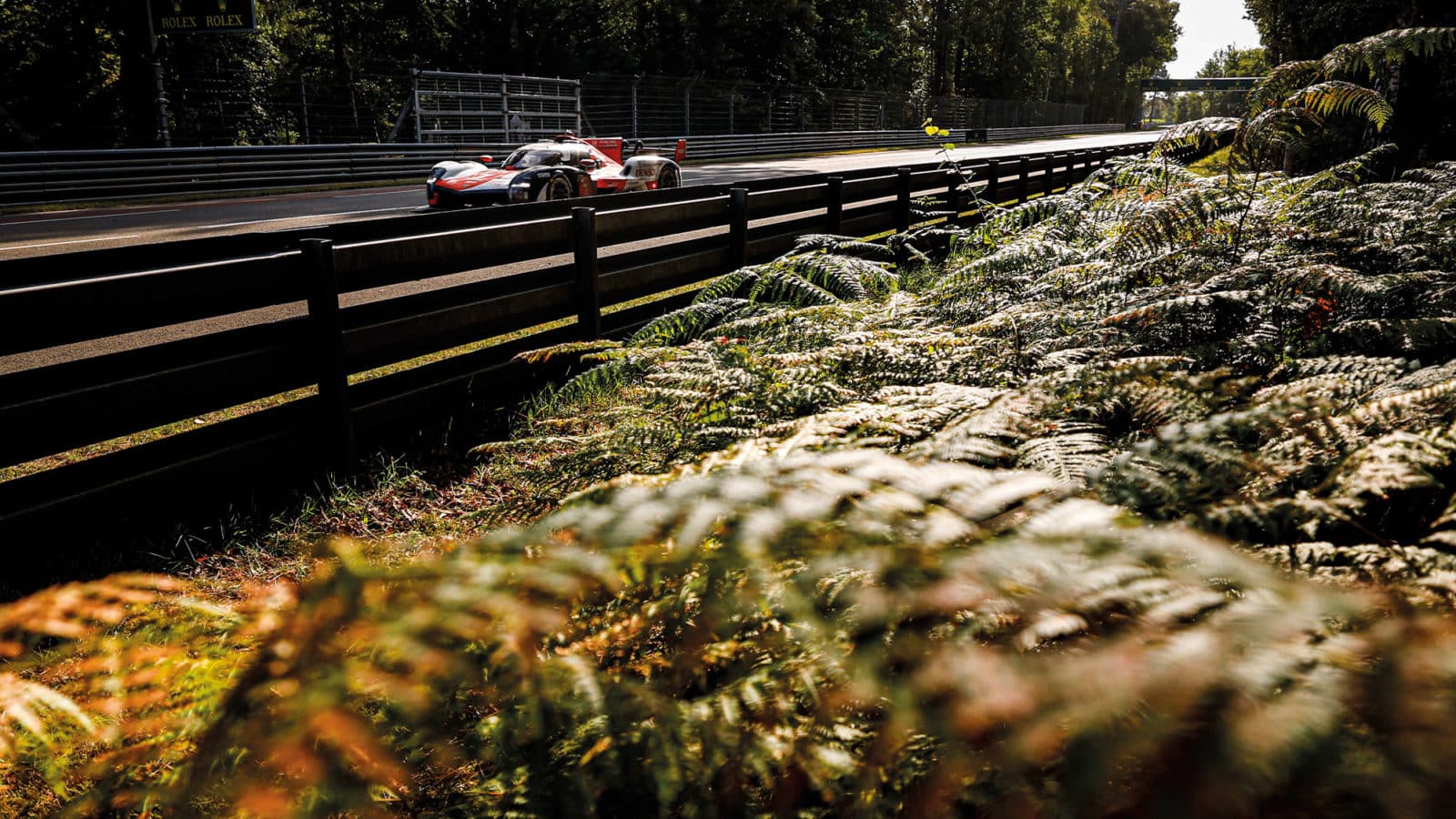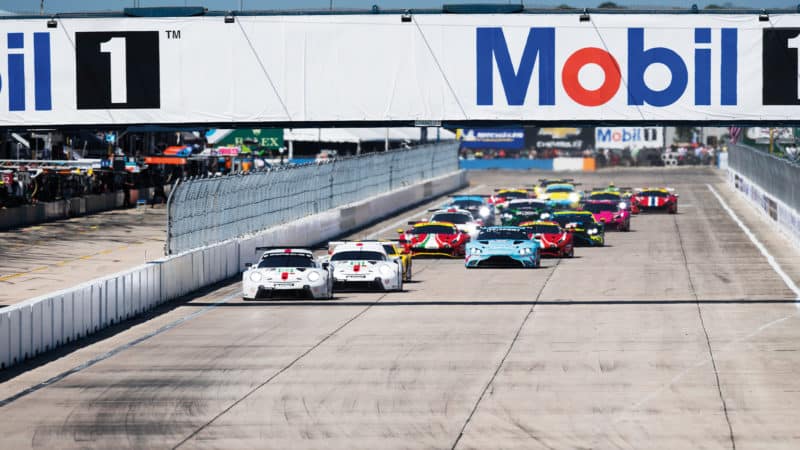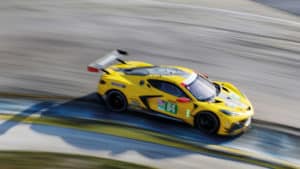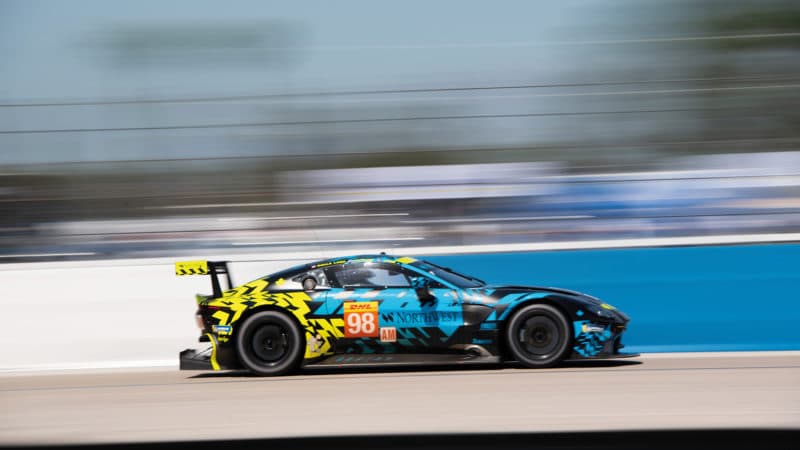2022 Le Mans 24 Hours guide: Welcome to the jungle
Can anyone beat Toyota? Will Penske shine in LMP2? And what next for GT racing? Gary Watkins guides you through the key questions ahead of the biggest endurance race of the year

DPPI
Toyota claimed a fourth Le Mans 24 Hours victory in a row in year one of the new era for sports car racing last August. The opposition for its pair of Le Mans Hypercars is the same this time around — two LMHs from Glickenhaus and one old-style LMP1 from Alpine — but it would be wrong to think that the Japanese manufacturer is shooting fish in a barrel as
the only major manufacturer on the grid. The rules of engagement in the Hypercar class of the World Endurance Championship have changed this season.
These changes have robbed the Japanese manufacturer’s GR010 Hybrid of one its key weapons. The speed at which the hybrid LMH contenders such as the Toyota can deploy electric power through the front wheels is now part of the system of Balance of Performance, the means by which the different cars are equalised, rather than laid down in the technical regulations. That resulted in an increase in that speed from 120kph (75mph)in the dry and 150kph (93mph) in the wet last year to 190kph (118mph) in all conditions at the opening round of the 2022 WEC at Sebring in March.
That doesn’t mean the hybrid deployment speed will be set at 190kph come Le Mans on June 11/12, but the Automobile Club de l’Ouest and the FIA, who jointly write the rules for the WEC, have suggested that the figure for each car will not change dramatically through the season. Whatever happens, the GR010’s front-axle energy-retrieval system will not be the significant performance tool it was in the past: hybrid power can now be used in only the fastest corners and on the straights.

Toyota’s Le Mans winning drivers in 2021 were Mike Conway, Kamui Kobayashi and José María López, who return for the 90th race
The revisions to the BoP process mean the landscape in the Hypercar class has changed dramatically since last year, insists Toyota Gazoo Racing Europe technical director Pascal Vasselon. “The new BoP is bringing everyone very close together in terms of performance,” he explains. “It’s a big change; there is a significantly different working point for us.”
The revised BoP for Sebring, which also included a small increase of the Toyota’s minimum weight from Le Mans last year and a power reduction, took its toll. The Toyotas weren’t a match for the winning Alpine A480 on the bumpy surface. Vasselon argued that the BoP model used by the rule makers didn’t correctly simulate the unique characteristics of the Sebring International Raceway.
That was as far as Toyota’s criticism went. Vasselon insists that the team has faith in the BoP process: “Now all the cars are reliable and heavily instrumented. Everything is available to understand what happened at Sebring. We can only trust the ACO and FIA to make best use of the data to ensure that for the rest of the championship things are working better.”
The other reason why Toyota believes it can take nothing for granted at Le Mans this year is that Glickenhaus has emerged as a credible contender. That was far from the case ahead of last August’s race.
“We now know Glickenhaus is able to last 24 hours; they are doing very well in terms of reliability,” says Vasselon of the American marque’s 007 LMH, which took fourth and fifth positions in the French enduro. “The situation is different compared with last year when we didn’t know where Glickenhaus was.”

While Alpine (centre) won the opening WEC round in Sebring, Toyota battled back at Spa
Getty Images
Vasselon describes Alpine as a “very serious competitor” with its grandfathered LMP1, which he points out is a well-proven design after starting out as the Rebellion R13 back in 2018/19. “We are not underestimating Alpine and certainly not Glickenhaus,” he says.
The Glickenhaus has the most room for improvement of the Hypercars. It focused on increasing the reliability of the non-hybrid 007 over the winter and conducted little or no meaningful testing ahead of Sebring. Fly-by-wire braking, allowed for rear-drive LMHs this year, was tried in practice at Sebring and raced at Spa, but the team reckons the system has still to be fine-tuned. There’s an advantage to be gained from it on both one-lap performance and tyre life. Vasselon concedes that Toyota is still the Le Mans favourite. A fifth in a row would equal Joest Audi’s record of consecutive wins from 2010 to ’14. But that won’t result in extra pressure, reckons Vasselon.
“In the past there was pressure because we’d never won Le Mans, and now there is pressure because we have won it so many times,” says Vasselon. “If we didn’t have pressure from outside, we would make sure we would put it on ourselves.”
A peak for P2?
LMP2 has never been so strong at Le Mans. Not only is there a record 27-car entry, but the grid has been bolstered by Team Penske, which is learning about the series ahead of its entry into the Hypercar class in ’23 with Porsche’s LMDh, and single-seater powerhouse Prema from Italy.

Team Penske is now fact-finding in LMP2
Getty Images
Champion WRT has stepped up to two full-season WEC entries, rather than running one in WEC and one in the European Le Mans Series, and also fields an additional entry at the 24 Hours. United Autosports and Jota are back with two cars in the WEC, while the cream of the crop from the ELMS is present, too. The increase in quality and quantity isn’t lost on the participants, 2019/20 WEC LMP2 champion team United included. “When we turned up at Sebring and I walked through the paddock, I realised what a visible step up there has been,” says United team boss Richard Dean. “You see some of the teams, drivers and personnel and you think, you could easily get left behind here. It’s time to roll the sleeves up. The pace is going to be ferocious and we’ve all got the same chassis, engine and tyres,” he continues, overlooking the presence of a single Ligier on the entry among the sea of ORECA 07s. “The details are going to be important.”
This year could well be the high-water mark for LMP2. The Hypercar class is going to expand over the next two years. Ferrari, Porsche and Cadillac arrive next year, while Alpine, Lamborghini and most likely BMW will be represented with LMDhs in the top class come 2024. That is inevitably going to put a squeeze on LMP2. There will be less room on the grid for P2s, whether or not some of the best teams from the class move up to the Hypercar ranks.
Last hurrah for GTE Pro
This will be the final slugfest between the factories in GTE Pro. All-professional line-ups won’t be allowed when a new GT class comes into force in 2024 and it’s clear that Ferrari and Porsche won’t be running works cars next season when they switch focus to their new prototypes under development for Hypercar whether or not the class continues.

There are seven LMGTE Pro entries at Le Mans this year, including the 911 RSR, leading, driven by Michael Christensen and Kévin Estre.
Getty Images
Porsche and Ferrari again go toe-to-toe with Chevrolet. The trio have been battling it out at Le Mans since the 2000s and have, more or less, been ever-present in the WEC era. The works AF Corse Ferrari squad has been on the grid for the 24 Hours every year since the rebirth of the WEC in 2012, while the factory Porsche squad has been a fixture since 2013. The Corvette Racing Chevy squad only missed the race in 2020 as a result of Covid.

The future of GT racing at Le Mans and in the WEC isn’t entirely clear right now. It was announced by the FIA and the ACO ahead of last year’s 24 Hours that the GTE rule book will be replaced by 2024 with something based on GT3, a global formula in which upwards of 10 manufacturers are represented. What is unclear is whether GTE Pro will continue for one final season next year. The ACO has said it will run the class if there is sufficient interest — it has suggested four cars representing two different manufacturers as a minimum — but there has already been a World Motor Sport Council vote to cull the class after this year, which was never made public. Whatever happens, there won’t be three factories on the grid. Relish GTE Pro while you can.
GTE Am
It’s Ferrari vs Porsche vs Aston Martin in the GTE Am class. The British manufacturer might have pulled out of the Pro ranks at the end of the 2019/20 WEC, but it’s still a force in the secondary GTE class.

NorthWest’s Aston Martin Vantage GTE has already tasted victory this year in the GTE Am class at Sebring
Getty Images
Three Aston Martin Vantage GTEs go up against the swathes of Italian and German cars in a field of 23. The NorthWest AMR entry, run by the works Prodrive squad, is joined by two cars fielded by the British TF Sport squad, one under the banner of Japanese entrant D’station Racing. TF won the class at only its third attempt in 2020 and finished second last year, while NorthWest is already a race winner in the WEC this season.
What no Peugeot?
Peugeot won’t be racing at Le Mans this year, but it would be wrong to suggest that it has delayed the entry of its new 9X8 LMH until after the French enduro. It might have filed two full-season entries for the 2022 WEC, but it never committed to taking part in the centrepiece round of the series. Full entries had to be made if it wanted to take part in the WEC this year: race-by-race participation isn’t allowed under the rules, so it clearly had an understanding with the organisers that it could turn up when it was ready and take the financial penalties for missing races.

A Peugeot-free Le Mans but the rear-wingless- wonder 9X8 might be given an outing at Monza
It is important to understand the timeline of the 9X8 project when making a judgement on Peugeot’s absence from Le Mans. A lot has changed since the French manufacturer announced its WEC entry in November 2019.
Two and a half years ago, the WEC was running to what was referred to as the winter-series format, meaning the season started at the back end of the summer and climaxed with Le Mans in June. That schedule fell over as a result of Covid: the WEC had no choice but to abandon it once the 2019/20 championship was extended until November 2020.
Peugeot’s original commitment was to be on the WEC grid by the start of the 2022/23 season. That was the hard deadline, although it didn’t rule out taking part in some late-season races in what would have been the 2021/22 series. Should the 9X8 be on the grid for round four of this year’s WEC at Monza in July it would still be ahead of the schedule outlined in 2019.
“Peugeot has maintained there are no conceptual issues with the 9X8”
Peugeot knows it can’t rush into the WEC because of the limitations on development in the new era of sports car racing. Once a car is homologated its specification is largely frozen for the life of the formula, which means up to the end of ’25 for the 9X8 at the very least.
Only five so-called ‘evo jokers’ are allowed on performance grounds, and they have to be applied for. The rules are effectively free on improvements concerning reliability, though again permission is required.
Peugeot couldn’t take the risk of starting to race a car that didn’t begin testing until just before Christmas until it was sure it was confident the 9X8 could perform. It stressed about a need to focus on reliability when, in late February, it announced its decision not to race at the Spa 6 Hours and then Le Mans. It has consistently maintained, however, that there are no conceptual issues with the 9X8.
That suggests that when the car does race this summer, it will very much resemble the show car unveiled last summer. And that means no conventional rear wing.
